22.42.060 Single-family residential design standards.
A. Purpose. This section provides supplemental direction for the design of new residential developments consistent with the goals and policies of the comprehensive plan. Development should, to the extent possible, incorporate substantive building elements and varied materials that maintain Monroe’s existing “small town” character. This includes:
1. Creating well-designed, detailed buildings that highlight subtle and refined design elements including decorative building materials such as tile, timbers and metalwork.
2. Stylistically distinguishing new buildings from existing buildings.
3. Creating a varied, nonhomogenous set of buildings within the neighborhood that provide a sense of evolution rather than the appearance of a one-step development.
4. Providing a variety of finish materials, colors or textures on building elements to provide further articulation, add variety and define building details.
5. Using high quality building materials that enhance the character of the area.
B. General Provisions.
1. Elevations and Models. Elevations and models are required to ensure that new developments provide a diverse streetscape with a variety of floor plans and frontage character.
a. Residential buildings shall avoid a uniform appearance by providing variation in building architecture and elevations using methods such as building modulation, primary and secondary building forms (e.g., covered porches, dormers, window bays), and changes in exterior materials, colors, windows, doors, and trim.
b. The same elevation shall not be built next to each other or across the street from each other.
c. To differentiate the same elevations, different colors and materials shall be used. The following major elements must be substantially different (see Figure 22.42.060(B)(1)):
i. Building configuration/massing.
ii. Roof type (gable, hip, shed, etc.).
Figure 22.42.060(B)(1). Variation in Elevations and Models

d. The following minor features must be substantially different:
i. Finish color (siding, roofing, or trim).
ii. Siding style.
iii. Window configuration, architectural detailing or elements.
2. Architecture Detail and Features. To ensure the appropriate scale and to provide elements of human interest, at least one architecture feature shall be used in residential buildings. These elements shall follow the home’s architectural style. Architectural features include, but are not limited to:
a. Shutters (proportional to window).
b. Flower boxes.
c. Knee braces.
d. Columns.
e. Trellises.
Figure 22.42.060(B)(2). Examples of Architectural Details
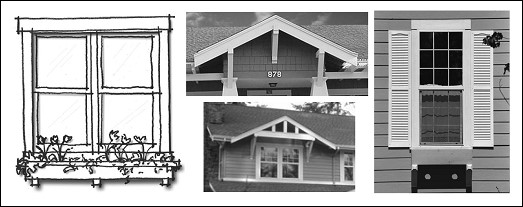
3. Massing and Composition. A clear pattern of massing changes and modulation of building forms and composition is required to create architectural variety and interest.
a. Primary building forms shall be the dominating form while secondary formal elements shall include porches, dormers, or other significant features.
b. Secondary roof forms, such as dormers, shall be proportional to the primary roof form.
Figure 22.42.060(B)(3). Building Form Examples
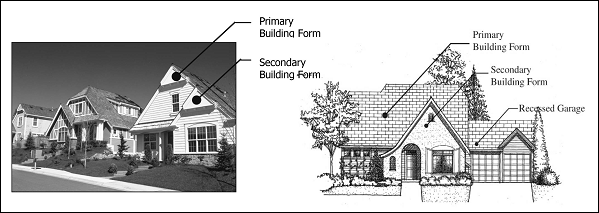
4. Building Modulation. Building modulation is required to avoid monotonous repetition of elevations, reduce bulk and mass, and provide pedestrian scale elements adjacent to the streetscape. Buildings shall have a consistent visual identity on elevations visible to the public realm (e.g., public/private streets, sidewalks, and common areas). This should be achieved by providing similar levels of materials, detailing and window placement.
5. Roof Overhangs. Roof overhangs shall be a minimum of twelve inches (excluding gutter). Overhangs and eaves should be detailed and proportioned to complement the architectural style of the home.
Figure 22.42.060(B)(5). Roof Overhangs
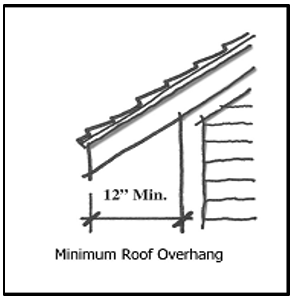
6. Building Transparency.
a. Doors.
i. Front doors shall be in keeping with the architectural style of the structure.
ii. Front doors shall be paneled or have inset windows (see Figure 22.42.060(B)(6)(a)).
iii. A three and one-half-inch minimum head and jamb trim is required around all doors.
Figure 22.42.060(B)(6)(a). Acceptable Doors
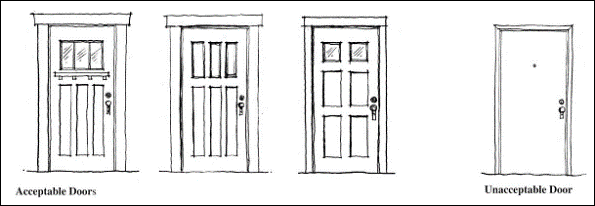
b. Primary Windows.
i. Windows are required to have a trim on all building facades fronting the public right-of-way or access easement.
ii. Trim must be appropriate to the architectural character of the home and be a minimum of three and one-half inches wide.
iii. Vertical windows may be combined together to create a larger window area.
iv. Divided light windows are encouraged. They must either be true divided light or have properly proportioned mullions applied to the window. Individual panes must be vertically proportioned or square (see Figure 22.42.060(B)(6)(b)).
Figure 22.42.060(B)(6)(b). Acceptable Windows
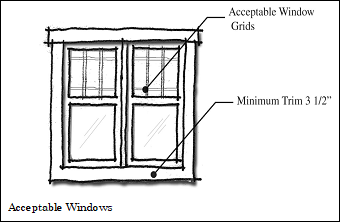
7. Parking, Garages, and Vehicular Access. Design standards for parking, garages and vehicular access are necessary to mitigate parking and traffic impacts and preserve the aesthetic quality of homes, and to minimize the negative impacts of vehicular access and parking areas on the streetscape and pedestrian environment.
a. Garages – General.
i. A single car garage shall be a minimum of nineteen feet in depth and ten feet in width (unobstructed).
ii. A two-car garage shall be a minimum of nineteen feet in depth and twenty feet in width (unobstructed).
iii. A tandem two-car garage shall be a minimum of thirty-eight feet in depth and ten feet in width.
b. Front-Loaded Garages. Front-loaded garages shall be set back a minimum of two feet from the front building facade (see Figure 22.42.060(B)(7)(b)). Front-loaded tuck-under garages may be permitted subject to zoning administrator’s approval on sites that slope downward from the street only if they reduce the negative visual impact of the garage and where each garage entry is individually articulated.
Figure 22.42.060(B)(7)(b). Front-Loaded Garage
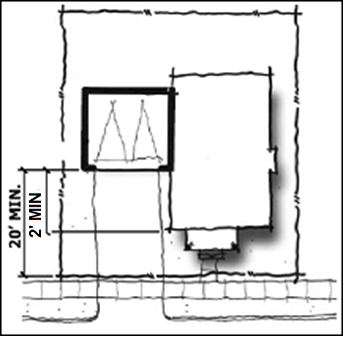
c. Tuck-Under Garages.
i. Tuck-under garages must be set back from the primary facade a minimum of two feet. Where used, tuck-under garages and associated driveways shall provide sufficient width for a driver to comfortably maneuver a vehicle into and out of the garage.
Figure 22.42.060(B)(7)(c). Tuck-Under Garage
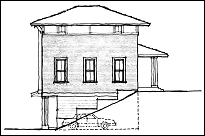
ii. The cumulative garage door in the R4 zone shall occupy no more than fifty percent of the lineal, ground level facade facing the street, except as follows:
(A) Cul-de-sac lots. Additional design elements shall be included to reduce the mass of the garage.
(B) Tuck-under garages.
(C) Detached garages are exempt from meeting the fifty percent of the ground level facade requirement.
d. Rear-Loaded Garages.
i. Driveway lengths shall either be five feet (reduced driveway) or a minimum of twenty feet (standard driveway) in length.
ii. Rear-loaded garages are not subject to the fifty percent facade requirement.
e. Side-Loaded Garages.
i. Side-loaded garages must be set back a minimum of fifteen feet from the designated front property.
ii. The side of the garage facing the street must provide windows and architectural design elements that mimic the overall design of the home, as well as landscaping in front of or along the garage wall for a depth of at least three feet.
iii. Driveways shall be separated from the sidewalk and front entry (stoop or porch) with lawn or landscape beds. Pedestrian entries shall be from the street and may not be accessed from the driveway.
iv. Where side-loaded garages are located behind a house (see Figure 22.42.060(B)(7)(e)), there is no limitation on their quantity in a plat.
v. Where side entry garages are located on adjoining lots, there shall be a minimum ten-foot landscape area between driveways with a maximum driveway width of fifteen feet. In lieu of two fifteen-foot driveways and the associated landscape requirements, the adjoining lots may be served by a single joint use driveway not exceeding fifteen feet in width.
Figure 22.42.060(B)(7)(e). Side-Loaded Garage
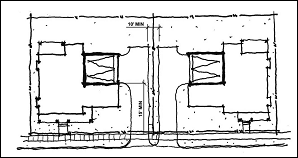
f. Additional Driveway Standards.
i. Tandem parking in garages is permitted for all housing types as long as spaces are identified for the exclusive use of occupants of a designated dwelling.
ii. Where lots abut an alley, the garage or off-street parking area must take access from the alley, unless precluded by steep topography. No curb cuts to the adjacent street shall be permitted unless access from the alley is precluded by steep topography. (Ord. 005/2019 § 10 (Exh. B))